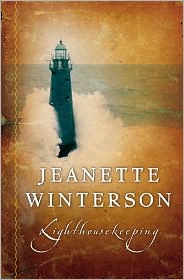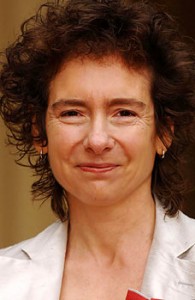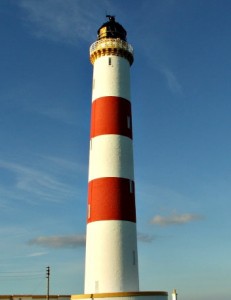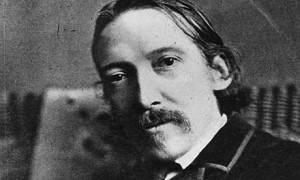“It was soon discovered that every light[house] had a story—not every light was a story, and the flashes themselves were the stories going out over the waves, as markers and guides and comfort and warning.”
 Jeanette Winterson’s beautiful and magnificently descriptive, impressionistic novel tells two interconnected stories from two different periods over a hundred years apart, each of them asking who we are as humans, what is our connection to the past, and what makes our lives worth living. On its most modern level, it is the story of Silver, born in 1959, “part precious metal, part pirate.” A young girl without a father, Silver and her mother live in a house perched precariously on the edge of a cliff in northwest Scotland—until her mother, strapped to ten-year-old Silver, one day falls in her climb back to the house, releasing her harness so that Silver, who becomes instantly an orphan, will live.
Jeanette Winterson’s beautiful and magnificently descriptive, impressionistic novel tells two interconnected stories from two different periods over a hundred years apart, each of them asking who we are as humans, what is our connection to the past, and what makes our lives worth living. On its most modern level, it is the story of Silver, born in 1959, “part precious metal, part pirate.” A young girl without a father, Silver and her mother live in a house perched precariously on the edge of a cliff in northwest Scotland—until her mother, strapped to ten-year-old Silver, one day falls in her climb back to the house, releasing her harness so that Silver, who becomes instantly an orphan, will live.
Taken in by Pew, the aged and blind local lighthousekeeper, whose family has kept the light since 1828, Silver notes that “All the light shone outwards and none of it was there for us. Pew was blind, so it didn’t matter to him. I was lost, so it didn’t matter to me.” Silver polishes the brasswork, makes the tea, and listens to Pew’s stories, some of them historical and some more fanciful, but all of them filled with wisdom and lessons from the past, to which Pew is permanently connected. The lighthouse, we learn through Pew’s stories, was built by Robert Stevenson, father of Robert Louis Stevenson, who “escaped” the family business. In 1878, ho wever, Robert Louis Stevenson visited the light and was fascinated by the story of Babel Dark, a local preacher, who became the inspiration for Mr. Hyde in Dr. Jekyll and Mr. Hyde and whose story represents the second of the story lines.
wever, Robert Louis Stevenson visited the light and was fascinated by the story of Babel Dark, a local preacher, who became the inspiration for Mr. Hyde in Dr. Jekyll and Mr. Hyde and whose story represents the second of the story lines.
Babel Dark, we learn through stories, is a handsome young man who falls in love with red-haired Molly in the early 1850s. When he sees her embracing another man, he is overcome with jealousy and abandons her, marrying another woman instead. He is soon drawn back to Molly, however, symbolically taking the name of Lux (meaning “light”) when he is with her. Like Mr. Hyde, he is unable to control his emotions, and he abuses the women in his life. “He was dark…the light in him never lit. The instruments were in place, and polished too, but the light was not lit.”
As Silver grows up, Pew encourages her to tell her own stories, which she does on her own terms: “A beginning, a middle, and an end is the proper way to tell a story. But I have difficulty with that method.” She has been encouraged to see the continuity of history and of life, as Pew does, and her stories reflect constant growth and change. When the lighthouse is eventually automated, she continues to see life’s continuities with the past, though she is always looking, in the present, for the love that Pew has shown her. Babel Dark, on the other hand, has been a traditional preacher, and sees no continuity with the past, believing instead in separate creation and the idea of man as the highest of God’s creations. When he meets Charles Darwin and then later discovers a cave of fossils in the side of a cliff, he is troubled by the idea that there might have been a “maverick god,” who developed life forms through trial and error, rather than in separate miracles of creation.
As the stories of Silv er and Babel Dark develop in parallel, the novel takes on operatic qualities, with the two stories often sounding like duets sung in counterpoint to each other, one voice light and the other dark. As Silver and Dark seek love and fulfillment, the primary human quality which separates man from Darwin’s animals, the cadence of Winterson’s writing rises and falls, swirls, and turns in upon itself, with the same motifs echoing throughout. Winterson creates deliberate parallels when she incorporates the story of Tristan and Isolde, along with a visit from Charles Darwin, into the narrative for emphasis.
er and Babel Dark develop in parallel, the novel takes on operatic qualities, with the two stories often sounding like duets sung in counterpoint to each other, one voice light and the other dark. As Silver and Dark seek love and fulfillment, the primary human quality which separates man from Darwin’s animals, the cadence of Winterson’s writing rises and falls, swirls, and turns in upon itself, with the same motifs echoing throughout. Winterson creates deliberate parallels when she incorporates the story of Tristan and Isolde, along with a visit from Charles Darwin, into the narrative for emphasis.
Both romantic and philosophical, Winterson offers much unique imagery. The odious Miss Pinch “always spoke like a life insurance policy.” Pew is a “silent, taciturn clamp of a man.” An Albanian family was “vacuum-packed into a ship,” the great-grandmother, “air-dried like a chili pepper, deep red skin and a hot temper; the grandmother, all sun-dried tomato, tough, chewy, skin split with the heat.” Her narrative tempo is flawless, the language elegant, and the characterization as sophisticated as necessary to convey the themes.
Like Silver, who has difficulty telling a story with a beginning, a middle, and an end, Winterson chooses to tell the story on her own terms, juxtaposing scenes from different time periods to show similarities and contrasts between two sets of lives, all of which come together thematically by the end of the book. The conclusion completes a circle by harking back to the beginning, and the reader who goes back to the first few pages will be richly rewarded with greater insights into her meanings. A rich novel which the reader will want to read slowly to savor, Lighthousekeeping marks a welcome return of Winterson to the compressed, poetic style of her earlier novels. (On my Favorites list for 2005)
Winterson chooses to tell the story on her own terms, juxtaposing scenes from different time periods to show similarities and contrasts between two sets of lives, all of which come together thematically by the end of the book. The conclusion completes a circle by harking back to the beginning, and the reader who goes back to the first few pages will be richly rewarded with greater insights into her meanings. A rich novel which the reader will want to read slowly to savor, Lighthousekeeping marks a welcome return of Winterson to the compressed, poetic style of her earlier novels. (On my Favorites list for 2005)
Notes: The author’s photo is from http://www.dailymail.co.uk
The Tarbatness Lighthouse in northwest Scotland, is the third tallest lighthouse in the country. It was built by Robert Stevenson, father of Robert Louis Stevenson and is easy to imagine as the place where Silver lived with Pew : http://www.geograph.org.uk
The photo of Robert Louis Stevenson accompanies a story about how Stevenson got the idea of Dr. Jekyll and Mr. Hyde. http://www.guardian.co.uk/ No mention is made there about Babel Dark being the inspiration for Mr. Hyde.
